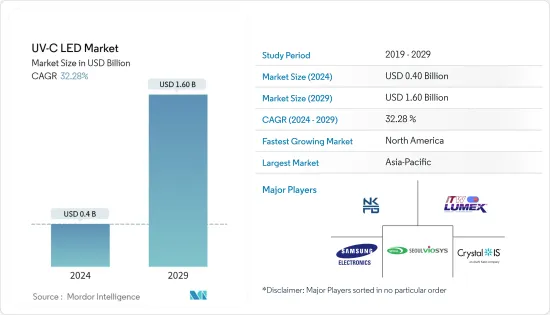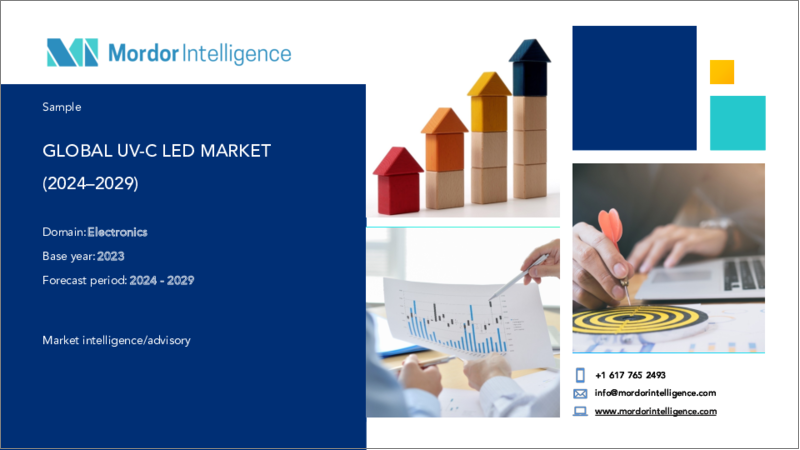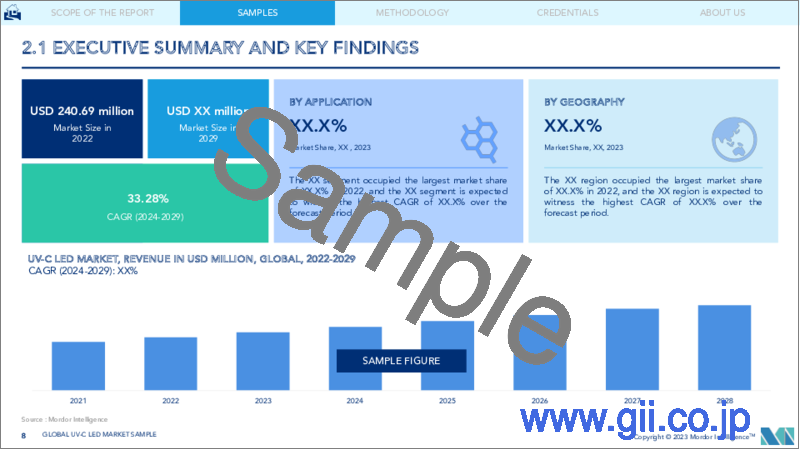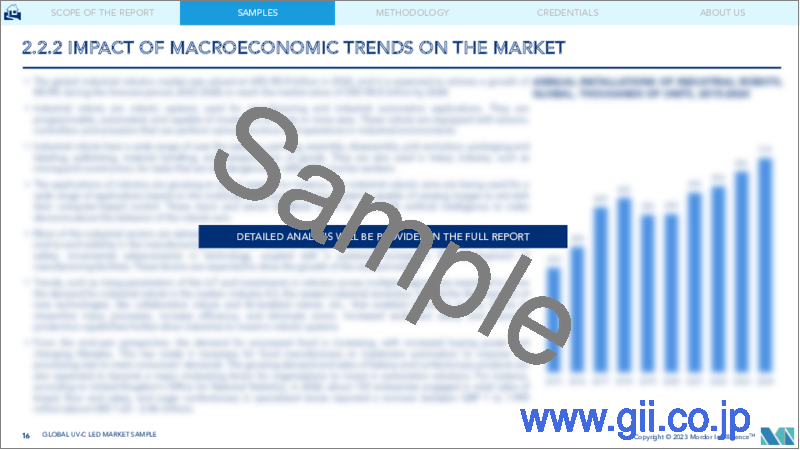|
|
市場調査レポート
商品コード
1441482
UV-C LED:市場シェア分析、業界動向と統計、成長予測(2024~2029年)UV-C LED - Market Share Analysis, Industry Trends & Statistics, Growth Forecasts (2024 - 2029) |
||||||
|
● お客様のご希望に応じて、既存データの加工や未掲載情報(例:国別セグメント)の追加などの対応が可能です。 詳細はお問い合わせください。 |
|||||||
| UV-C LED:市場シェア分析、業界動向と統計、成長予測(2024~2029年) |
|
出版日: 2024年02月15日
発行: Mordor Intelligence
ページ情報: 英文 132 Pages
納期: 2~3営業日
|
- 全表示
- 概要
- 目次
UV-C LED市場規模は2024年に4億米ドルと推定され、2029年までに16億米ドルに達すると予測されており、予測期間(2024年から2029年)中に32.28%のCAGRで成長します。

UV-C LEDは、半導体結晶のエレクトロルミネッセンスを通じてUV光子を生成します。これらの半導体結晶は通常、サファイアまたはAlN基板上に成長したAlGaN化合物でできています。これらのソリッドステートデバイスには水銀が含まれておらず、環境規制の対象となる他の物質に依存しません。その結果、従来の水銀含有 UVランプに代わる法規制に耐えられる代替手段となる可能性があります。
主なハイライト
- 予測期間中に、消費財や家電製品へのUV-C LEDの組み込みは、UV-C LED市場の成長に大きな機会をもたらすと予想されます。出力と信頼性の向上、および最近のUV-C LEDの単価低下も、市場の成長を大きく促進する追加の要因です。
- UV-C LEDの技術は徐々に進歩しています。水の浄化と消毒の商業化により、その製品の大きな市場が生まれました。これは、世界的にUV-C LEDの需要を促進する要因の1つです。 UV-C LEDは、選択的かつターゲットを絞った測定に焦点を合わせた波長を提供します。
- さらに、UV-C LEDは水に加えて表面と空気の消毒も行います。商業環境では、HAVC(暖房、換気、空調)用のUV-C LED空気清浄機の使用が増加しています。 UV-C LEDは、住宅、商業、ヘルスケア、輸送、ライフサイエンス、防衛、緊急対応などの幅広い業界で新しいサービスを採用しています。
- UV-C LEDはまだ初期段階にあるため、その熱管理は大きな問題です。 LEDは、他の電子部品と同様に、熱に非常に敏感です。 UV-C LEDは入力電力の約5%しか光に変換しません。これはLEDの外部量子効率(EQE)が特に低いことです。残りの95%の電力を変換することで熱が生成されます。
- COVID-19の発生は、世界のUV-C LED市場の拡大に影響を及ぼしました。これにより、殺菌紫外線(UV)技術への関心が急激に高まりました。 SARS-CoV-2およびその他の病原体は、従来型またはLED光源によって生成されるUV-C帯域放射線(100~280 nm)によって、表面、空気中、水中で不活性化されます。世界中で、多くの大学や研究室が、感染症の拡大を阻止するためにUV-C LEDベースの製品を開発しています。その結果、COVID-19が市場の成長を押し上げました。
UV-C LED市場動向
市場を牽引する水の消毒
- UV-C LEDは、川、海洋、その他の水域を汚染する危険な化学物質を使用せずに水を処理する安全で効率的な方法を提供します。 UVC-LEDは、水再生、廃水処理、飲料水、工業用および商業用プロセス水、プールやスパ、水産養殖、ライフサイエンスなどの用途で水を効率的に浄化するために使用されます。
- さらに、UV-C LEDをオンデマンド POU浄水システムに追加して、水系疾患の一般的な病原性原因から家庭を守ることができます。 UV-C LEDは、寄生虫、ウイルス、大腸菌、シュードモナス菌、レジオネラ菌など細菌を含む微生物汚染物質から保護するためにこれらのシステムで使用されます。
- 水の消毒にはワンパス式と貯水式の2種類があります。シングルパスタイプは家庭用浄水器などの流水に紫外線を照射して殺菌します。貯水型は加湿器などの貯水タンク内の水を照射して除菌します。
- 飲料水は、水源から消費までの処理プロセスのさまざまな段階でUV-C LEDで消毒されます。新しい技術を使用すると、LEDをさまざまな場所に配置して確実に除染することができます。 UV-Cモデルでは、水がきれいになるまでに数秒かかる場合があります。最初は、貯水池をいくつかの強力なLEDにさらして水を消毒することで機能します。これらは200 nm~280 nmの強力なUV-C光子を放出し、水中を移動して水生細菌の繁殖を防ぎます。
アジア太平洋地域が最大の市場シェアを占める
- 地域別は、主要なUV-C LEDサプライヤーが韓国と日本にあるため、アジア太平洋のUV-C LED市場は、予測期間中に最も顕著な市場シェアを保持すると予想されます。さらに、この地域では科学調査用のUV-C LEDの需要も増加しています。韓国の複数のLED企業が、韓国のサプライヤーの収益拡大に貢献する新しいUV-C LED製品シリーズを発売すると予想されます。
- 紫外線には原生動物、細菌、ウイルスで水を消毒する強力な殺菌力があるため、主にアジアの新興国で水系感染症の症例が増加しており、需要が拡大する傾向にあります。市場の成長は、産業廃液および廃水を処理するための先進技術の採用の増加によって刺激されています。
- 大手企業は、工業用水処理や都市飲料水などの大容量用途向けの高性能ソリューションを提供しています。さらに、政府の政策、急速な工業化、効率的な水と廃水処理への重点などの要因により、市場の成長が加速する態勢が整っています。
- 市場の成長は、ヘルスケア業界におけるUV-C LEDベースの機器の採用増加によっても促進されています。これらのデバイスは、効率的に消毒し、院内感染のリスクを軽減するために、患者病棟、手術室、その他のエリアに合わせて効果的に設計およびカスタマイズできます。
- 上下水処理部門は、ネパール、ブータン、バングラデシュ、インドなどのアジア諸国で都市および家庭の飲料水処理システムの受け入れが増加しているため、成長を遂げています。都市、商業、住宅用途を含む水処理セグメントは、UV消毒装置市場を独占しています。
UV-C LED業界の概要
UV-C LED市場は細分化されており、主要なプレーヤーで構成されています。市場シェアの点では、市場を絶対的にコントロールできる企業はなく、誰もが公平なシェアを持っています。
- 2022年10月:Crystal IS Inc.の親会社である旭化成は、UV-C LED技術をどのように適用して水処理において従来の水銀ランプシステムよりも高い消毒効率を達成できるかを実証しました。 Crystal ISと旭化成のUV-C LED(発光)技術の進歩は、社会の持続可能性に大きく貢献しており、水銀フリーの世界の実現に向けた重要な一歩です。
- 2022年 9月:AMS-OSRAMは、精製アプリケーション向けの高出力UV-C LEDポートフォリオを補完しました。 OsramのOSLON UV 6060は、265ナノメートルの単一ダイソースから強力な100ミリワットを提供します。発光波長は最高の殺菌効果をもたらします。 AMS-OSRAMのOSLON UV 6060は、産業用途のニーズを満たし、クリーンで浄化された環境のための持続可能なUV-C処理ソリューションを提供します。
その他の特典
- エクセル形式の市場予測(ME)シート
- 3か月のアナリストサポート
目次
第1章 イントロダクション
- 調査の前提条件と市場の定義
- 調査範囲
第2章 調査手法
第3章 エグゼクティブサマリー
第4章 市場洞察
- 市場概要
- COVID-19の市場への影響
- 業界の魅力- ポーターのファイブフォース分析
- 供給企業の交渉力
- 買い手の交渉力
- 新規参入業者の脅威
- 代替品の脅威
- 競争企業間の敵対関係の激しさ
- 価格分析
- 全体的なUVランプ分析
- UV-C LEDテクノロジー- 製造プロセス
第5章 市場力学
- 市場促進要因
- 除菌効果の高いUV-C LED
- 浄水導入の急増
- 市場抑制要因
- UV-C LEDの熱管理
第6章 市場セグメンテーション(価値と量による市場規模)
- 用途別
- 表面の消毒
- 空気消毒
- 水の消毒
- 地域別
- 南北アメリカ
- アジア太平洋地域
- 欧州、中東・アフリカ
第7章 競合情勢
- 企業プロファイル
- NKFG Corporation
- Nitride Semiconductor Co. Ltd
- Samsung Electronics Co. Ltd
- Lumex Inc.(ITW Inc.)
- Crystal IS Inc.(Asahi Kasei Group)
- Seoul Viosys Co. Ltd
- Hongli Zhihui Group
- LiteOn Technology Corporation
- Luminus Inc.
- AMS-Osram AG
- International Light Technologies Inc.
- Nichia Corporation
第8章 ベンダー市場シェア分析
第9章 市場の将来展望
The UV-C LED Market size is estimated at USD 0.4 billion in 2024, and is expected to reach USD 1.60 billion by 2029, growing at a CAGR of 32.28% during the forecast period (2024-2029).

UV-C LEDs produce UV photons through the electroluminescence of a semiconductor crystal. These semiconductor crystals are typically made of AlGaN compounds grown on sapphire or AlN substrates. These solid-state devices contain no mercury and do not rely on other substances that are subject to environmental restrictions. As a result, they may provide a regulatory-proof alternative to traditional mercury-containing UV lamps.
Key Highlights
- During the forecast period, the incorporation of UV-C LED into consumer goods and home appliances is anticipated to present a significant opportunity for the growth of the UV-C LED market. Improvements in output power and reliability and the recent unit cost price reduction for UV-C LEDs are additional factors significantly fueling the market growth.
- The technology of UV-C LEDs is gradually becoming better. The commercialization of water purification and disinfection has resulted in a sizeable market for the products. This is one of the factors driving UV-C LED demand globally. UV-C LEDs provide a focused wavelength for selective and targeted measurements.
- Moreover, UV-C LEDs offer surface and air disinfection in addition to water. In the commercial environment, the use of UV-C LED air purifiers for HAVC (heating, ventilation, and air conditioning) is rising. UV-C LEDs are finding new services in a wide range of industries, including residential, commercial, healthcare, transportation, life sciences, defense, and emergency response.
- The thermal management of UV-C LEDs is a major problem because the technology is still in its infancy. LEDs are extremely heat-sensitive, just like any other electronic component. UV-C LEDs only convert about 5% of the input power into light, which is a particularly low external quantum efficiency (EQE) for LEDs. Heat is created by converting the remaining 95% of the power.
- The COVID-19 outbreak had affected the expansion of the global UV-C LED market. It sparked a meteoric rise in interest in germicidal ultraviolet (UV) technology. SARS-CoV-2 and other pathogens can be rendered inactive on surfaces, in the air, and in water by UV-C band radiation (100-280 nm) produced by conventional or LED sources. Around the world, numerous universities and laboratories are creating UV-C LED-based products to stop the spread of infections. As a result, COVID-19 boosted the market's growth.
UV-C LED Market Trends
Water Disinfection to Drive the Market
- UV-C LEDs provide a safe, efficient method of treating water without the use of risky chemicals that contaminate rivers, oceans, and other bodies of water. UVC-LEDs are used to efficiently purify water in applications such as water reclamation, wastewater treatment, drinking water, industrial and commercial process water, pools and spas, aquaculture, and life sciences.
- Moreover, UV-C LEDs can be added to on-demand POU water purification systems to safeguard households against common pathogenic causes of waterborne illnesses. UV-C LEDs are used in these systems to protect against microbial contaminants, which include parasites, viruses, and bacteria like e. coli, pseudomonas, and legionella.
- There are two types of water disinfection, namely single-pass type and water storage type. A single-pass type irradiates ultraviolet to disinfect running water, such as a household water purification system. A water storage type irradiates and disinfects water inside a water storage tank, such as a humidifier.
- Drinking water is sanitized with UV-C LEDs at various stages of the treatment process, from the source to consumption. With the new technology, LEDs can be positioned at different points to ensure decontamination. In a UV-C model, it can take a few seconds for the water to become clean. It initially functions by disinfecting the water by exposing a reservoir to several powerful LEDs. They release potent UV-C photons between 200 nm and 280 nm, which travel through the water and prevent aquatic bacteria from being able to procreate.
Asia-Pacific Accounts for the Largest Market Share
- Geographically, the UV-C LEDs market in Asia-Pacific is expected to hold the most prominent market share during the forecast period because the main UV-C LED suppliers are in South Korea and Japan. Moreover, the region is also experiencing a rise in the demand for UV-C LEDs for scientific research. It is anticipated that several South Korean LED companies are going to launch new series of UV-C LED products contributing to expanding the revenue of South Korean suppliers.
- Increasing cases of water-borne diseases, primarily in emerging countries across Asia, are poised to augment demand as UV radiation holds a strong germicidal ability to disinfect water with protozoans, bacteria, and viruses. The market growth is stimulated by the increasing adoption of advanced technologies to treat industrial liquid waste and wastewater.
- Leading companies are offering high-performance solutions for large-volume applications like industrial water treatment and municipal drinking water. In addition, factors such as government policies, rapid industrialization, and a strong focus on efficient water and wastewater treatment are poised to expedite the growth of the market.
- The growth of the market is also favored by the increasing adoption of UV-C LED-based equipment in the healthcare industry. These devices can be effectively designed and customized for patient wards, operating rooms, and other areas for efficient disinfection and mitigating the risk of hospital-acquired infections.
- The water and wastewater treatment segment is witnessing growth owing to increased acceptance of both municipal as well as household drinking water treatment systems across Asian countries such as Nepal, Bhutan, Bangladesh, and India. The water treatment segment, which includes municipal, commercial, and residential applications, dominates the UV disinfection equipment market.
UV-C LED Industry Overview
The UV-C LED market is fragmented and consists of major players. In terms of market share, no company has absolute control over the market, and everyone has their fair share. Major players include NKFG Corporation, Nitride Semiconductor Co. Ltd, Samsung Electronics Co. Ltd, Lumex Inc. (ITW Inc.), and Crystal IS Inc. (Asahi Kasei Group).
- October 2022: Asahi Kasei, the parent company of Crystal IS Inc., demonstrated how the UV-C LED technology could be applied to achieve higher disinfection efficiency in water treatment than conventional mercury lamp systems. Crystal IS and Asahi Kasei's advancements in UV-C LED (light-emitting) technology contribute majorly to society's sustainability and are essential steps toward actualizing a mercury-free world.
- September 2022: AMS-OSRAM complemented its high-power UV-C LED portfolio for purification applications. Osram's OSLON UV 6060 offers powerful 100 milliwatts out of a single die source at 265 nanometers. The emission wavelength provides the highest germicidal effectiveness. The OSLON UV 6060 from AMS-OSRAM meets the needs of industrial applications delivering sustainable UV-C treatment solutions for a clean and purified environment.
Additional Benefits:
- The market estimate (ME) sheet in Excel format
- 3 months of analyst support
TABLE OF CONTENTS
1 INTRODUCTION
- 1.1 Study Assumptions and Market Definition
- 1.2 Scope of the Study
2 RESEARCH METHODOLOGY
3 EXECUTIVE SUMMARY
4 MARKET INSIGHTS
- 4.1 Market Overview
- 4.2 Impact of COVID-19 on the Market
- 4.3 Industry Attractiveness - Porter's Five Forces Analysis
- 4.3.1 Bargaining Power of Suppliers
- 4.3.2 Bargaining Power of Buyers
- 4.3.3 Threat of New Entrants
- 4.3.4 Threat of Substitutes
- 4.3.5 Intensity of Competitive Rivalry
- 4.4 Pricing Analysis
- 4.5 Overall UV Lamp Analysis
- 4.6 UV-C LED Technology - Manufacturing Process
5 MARKET DYNAMICS
- 5.1 Market Drivers
- 5.1.1 UV-C LED is Highly Effective for Disinfection
- 5.1.2 Surge in Adoption of Water Purification
- 5.2 Market Restraints
- 5.2.1 Thermal Management of UV-C LED
6 MARKET SEGMENTATION (MARKET SIZE BY VALUE AND VOLUME)
- 6.1 By Application
- 6.1.1 Surface Disinfection
- 6.1.2 Air Disinfection
- 6.1.3 Water Disinfection
- 6.2 By Geography
- 6.2.1 Americas
- 6.2.2 Asia Pacific
- 6.2.3 Europe, Middle East, and Africa
7 COMPETITIVE LANDSCAPE
- 7.1 Company Profiles
- 7.1.1 NKFG Corporation
- 7.1.2 Nitride Semiconductor Co. Ltd
- 7.1.3 Samsung Electronics Co. Ltd
- 7.1.4 Lumex Inc. (ITW Inc.)
- 7.1.5 Crystal IS Inc. (Asahi Kasei Group)
- 7.1.6 Seoul Viosys Co. Ltd
- 7.1.7 Hongli Zhihui Group
- 7.1.8 LiteOn Technology Corporation
- 7.1.9 Luminus Inc.
- 7.1.10 AMS-Osram AG
- 7.1.11 International Light Technologies Inc.
- 7.1.12 Nichia Corporation




